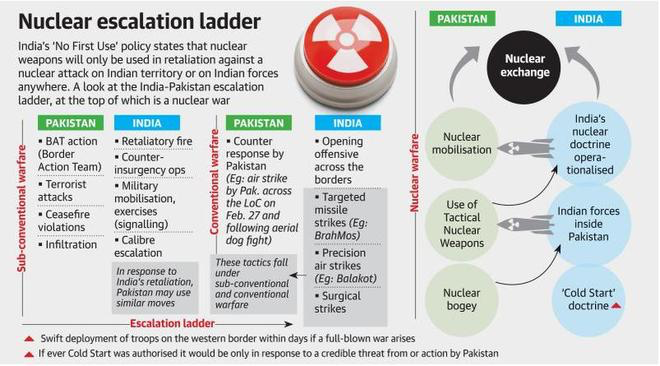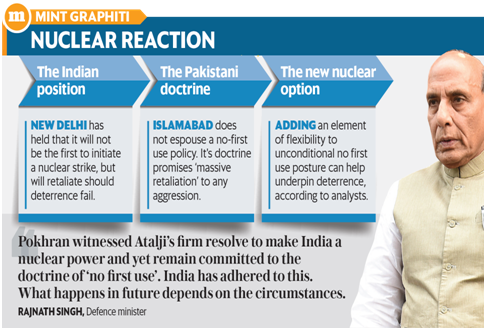ForumIAS announcing GS Foundation Program for UPSC CSE 2025-26 from 19 April. Click Here for more information.
ForumIAS Answer Writing Focus Group (AWFG) for Mains 2024 commencing from 24th June 2024. The Entrance Test for the program will be held on 28th April 2024 at 9 AM. To know more about the program visit: https://forumias.com/blog/awfg2024
Contents
- 1 Introduction
- 2 What are the key features of India’s Nuclear Doctrine?
- 3 What is the evolution of India’s nuclear doctrine?
- 4 What are the advantages of India’s nuclear doctrine?
- 5 What are the challenges raised against India’s nuclear doctrine?
- 6 What are the implications of shifting from the present nuclear doctrine?
- 7 What should be done?
| For 7PM Editorial Archives click HERE → |
Introduction
Marking 25 years since the Pokhran tests, India’s nuclear doctrine has seen significant evolution. With noteworthy advancements such as the Agni-V missile and the S-4, India’s third indigenous nuclear ballistic missile submarine, India has certainly bolstered its nuclear capabilities. However, it still grapples with challenges in securing the sea and air components of its nuclear triad and building a robust ballistic missile defence system. Furthermore, the swift expansion of China’s nuclear arsenal presents a fresh set of challenges. This milestone is an opportune time to reflect on the doctrine’s journey and its future direction in a shifting geopolitical landscape.
What are the key features of India’s Nuclear Doctrine?
Key features of India’s Nuclear Doctrine are:
No First Use (NFU): India committed to not being the first to use nuclear weapons in a conflict but would retaliate if attacked with such weapons.
Credible Minimum Deterrence: India would maintain a sufficient number of nuclear weapons to deter a nuclear attack, but it would not seek to match other countries’ arsenals in size.
Non-use Against Non-Nuclear Weapon States: India would not use or threaten to use nuclear weapons against countries that do not possess them.
Retaliation to a Nuclear Attack: If India is subject to a nuclear attack, it would retaliate, causing massive damage to the aggressor.
What is the evolution of India’s nuclear doctrine?
Origin of India’s Nuclear Doctrine: India’s nuclear doctrine originated in the years following its first nuclear test in 1974, which was termed as a ‘peaceful nuclear explosion.’ However, the real evolution of its nuclear doctrine began after the 1998 nuclear tests, when India declared itself a nuclear weapon state.
Draft Nuclear Doctrine (1999): Following the 1998 tests, the National Security Advisory Board (NSAB) of India released a Draft Nuclear Doctrine in 1999. This draft provided the basic framework of India’s nuclear policy, emphasizing a policy of ‘No First Use’ (NFU) and asserting that nuclear weapons would only be used for retaliation against a nuclear attack.
Official Nuclear Doctrine (2003): In 2003, the Indian government reviewed and released the official nuclear doctrine. It retained the core principles of the 1999 draft but added more details. The 2003 doctrine emphasized “Credible Minimum Deterrence,” reasserted the ‘No First Use’ policy, and stated that India would not use nuclear weapons against non-nuclear weapon states.
Current Debates: Given the evolving regional security environment, especially the growing nuclear capabilities of China and the persisting threat from Pakistan, there are ongoing debates in India about whether changes or clarifications to the nuclear doctrine are necessary. Some argue for a review of the ‘No First Use’ policy, while others believe that the principle of ‘Credible Minimum Deterrence’ might need to be reinterpreted in the face of new threats.
What are the advantages of India’s nuclear doctrine?

Credibility and Clarity: India’s nuclear doctrine provides a clear and credible stance on the country’s position regarding the use of nuclear weapons. The “No First Use” policy clearly signals that India views nuclear weapons primarily as a deterrent and not as an offensive tool, which contributes to regional stability.
Promotes peace and stability: The doctrine, particularly the “No First Use” and “Non-use Against Non-Nuclear Weapon States” provisions, contributes to regional and global peace and stability. These principles assure non-nuclear weapon states that they will not be threatened or attacked with nuclear weapons by India.
Supports Disarmament Goals: The “Credible Minimum Deterrence” stance aligns India with global disarmament goals and reduces the chances of a costly arms race.
Reinforces India’s Responsible Image: The doctrine’s principles, especially the “No First Use” policy and “Non-use Against Non-Nuclear Weapon States”, reinforce India’s image as a responsible nuclear power. This has strategic benefits for India in terms of its international standing and relations with other countries.
Mitigates the Risk of Accidental Nuclear War: The doctrine’s “No First Use” policy reduces the risk of an accidental nuclear war, as it removes the pressure for a rapid decision to launch in a crisis. This allows for a more measured response, potentially averting catastrophe.
What are the challenges raised against India’s nuclear doctrine?

Changing Regional Dynamics: India’s nuclear doctrine is being tested by the rapidly changing security dynamics in its region. The modernization and expansion of China’s nuclear capabilities pose a significant challenge to India’s policy of minimum deterrence. This transformation in the nuclear landscape could potentially strain India’s ability to respond effectively in a crisis.
Pakistani Tactical Nuclear Weapons: Pakistan’s development of tactical nuclear weapons challenges India’s NFU policy. The use of such weapons in a limited war scenario could potentially escalate the conflict, putting India in a difficult position given its NFU commitment.
Credibility of No First Use Policy: The NFU policy’s credibility has also been questioned. Doubts arise about whether India would stick to its NFU commitment if it had reliable information about an imminent nuclear strike. This ambiguity could potentially undermine the doctrine’s deterrence value.
Credibility of Deterrence: India’s commitment to a “Minimum Credible Deterrence” raises questions about whether it possesses enough nuclear weapons to effectively deter potential aggressors, particularly given China’s rapid military modernisation and nuclear expansion.
Lack of Counter-Force Strategy: India’s nuclear doctrine does not explicitly mention a counter-force strategy, focusing on enemy military assets. Critics argue that this could potentially limit India’s strategic options in the event of a nuclear conflict.
Vulnerability to First Strike: The “No First Use” policy potentially exposes India to a damaging first strike from an adversary. Critics argue that in such a case, India’s ability to launch a retaliatory strike could be significantly compromised.
What are the implications of shifting from the present nuclear doctrine?
Elevated Regional Tensions: If India were to abandon its “No First Use” policy, it could escalate tensions in the region, particularly with Pakistan and China, who might interpret such a move as a sign of increased aggression.
Arms Race: A shift in India’s nuclear doctrine could potentially trigger an arms race, with neighbouring countries feeling the need to expand their own nuclear arsenals in response to India’s perceived shift in stance.
International Reputation: India has traditionally been viewed as a responsible nuclear state, due in part to its “No First Use” policy and commitment to minimum credible deterrence. Altering this doctrine could tarnish that reputation and lead to international criticism.
Destabilize the region: The current doctrine contributes to strategic stability in the region by making it clear that India’s nuclear weapons are purely for deterrence and defensive purposes. A shift in this policy could destabilize the region by creating uncertainty around India’s intentions.
Resource Allocation challenges: A change in doctrine, particularly one leading to the expansion of India’s nuclear arsenal, would require substantial financial resources. This could divert funds from other critical areas like conventional military capabilities or economic development.
What should be done?
Maintain Strategic Restraint: India should continue to adhere to its current nuclear doctrine of “No First Use” and “Credible Minimum Deterrence”. These policies have served India well by maintaining regional stability and preserving its international reputation as a responsible nuclear state.
Engage in Dialogue: India should engage in regular strategic dialogues with its nuclear-armed neighbours, China and Pakistan. This can help in managing mutual concerns, reducing misunderstandings, and preventing potential conflicts.
Strengthen Conventional Capabilities: While maintaining a credible nuclear deterrent, India should also focus on strengthening its conventional military capabilities. This can help deter conventional conflicts that may escalate to the nuclear level.
Promote Nuclear Disarmament: India should continue advocating for global nuclear disarmament and non-proliferation. This includes supporting international treaties aimed at nuclear disarmament and urging other nuclear states to adopt “No First Use” policies.
Enhance Crisis Management Mechanisms: India should work with other regional actors to enhance crisis management mechanisms. This could include establishing hotlines, conducting joint military exercises, and agreeing on confidence-building measures to prevent accidental escalation during times of crisis.
Invest in Missile Defense Systems: To counter the growing threat from China’s modernizing nuclear arsenal, India should invest in developing and deploying advanced missile defense systems. This could offer an additional layer of protection against potential nuclear strikes.
Cooperate with Allies: India should continue to cooperate with its allies and partners, such as the United States, to deter potential aggressors. This could involve sharing intelligence, conducting joint military exercises, and coordinating on defence strategies.
Sources: Indian Express (Article 1, Article 2 and Article 3), The Hindu, ORF (Article 1 and Article 2), Times of India and South Asian Voice
Syllabus: GS 2: International Relations – India’s Nuclear Policy.




